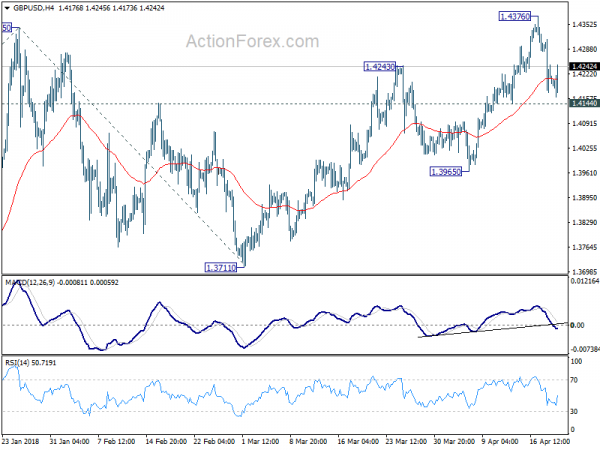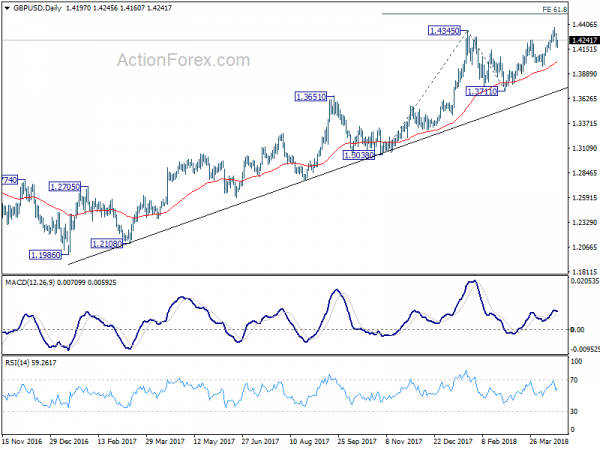The major theme in the forex markets isn’t too clear today. Sterling dips initially after retail sales missed expectation, but quickly recovered. Canadian dollar also pare back some of the post BoC decline, as lifted by strength in oil price. Australian Dollar gained earlier today but there is no follow through buying. Dollar continues to trade mixed. In particular, EUR/USD and USD/JPY are gyrating in very tight range. EUR/JPY edged slightly higher, with very week momentum. The more exciting development today is EUR/CHF hits as high as 1.1998/9 (depending on which feed you’re reading) but struggles to break through that historical 1.2 handle so far.
Economic data released in US session also provide little inspiration. US jobless claims dropped 1k to 232k in the week ended April 21, slightly above expectation of 230k. Four week moving average rose 1.25k to 231.25k. Continuing claims dropped 15k to 1.86m in the week ended April 14. Philly Fed survey rose fro 22.3 to 23.2 in April. Canada ADP payrolls rose to 42.8k in March.
UK retail sales missed, petrol sales dropped on snow, by online sales surged
UK retail sales including auto and fuel dropped -1.2% mom in March, well below expectation of -0.6%. Annual rate rose 1.1% yoy, below expectation of 1.9% yoy. Retail sales excluding auto and fuel dropped -0.5%, below expectation of -0.4%. Annual rate rose 1.1% yoy, below expectation of 1.4% yoy. The ONS noted in the release that mom decline was “a likely consequence of adverse weather conditions, which impacted travel.”
Rhian Murphy, ONS Senior Statistician said that the sharp fall in Q1 retail sales was due to “a large decline in March with petrol sales seeing a significant slump as a result of the poor weather keeping many shoppers indoors.” Nonetheless, “the snow actually helped boost online spending with department stores in particular seeing growth in their web sales.”
Germany’s Joint Economic Forecast Project Group raised 2018 and 2019 growth projections
In the twice a year published Joint Economic Forecast by leading German institutes, growth projection for 2018 and 2019 were raised to 2.2% and 2.0% respectively. Both were upwardly revised by 0.2% from Autumn report. The released warned that while German economy “continues to boom”, “the air is getting thinner”. Still, “pace of economic expansion nevertheless remains brisk:” It pointed to upturn in the world economy, favorable situation in labor market and fiscal stimulus of the new coalition government as driving forces. Inflation is projected to slow to 1.7% in 2018 then rise again to 1.9% in 2019.
Global growth projection was revised up by 0.3% to 3.4% in 2018. The reported noted that “tax cuts in the USA will stimulate economic activity there, which may have a knock-on effect on other countries”. However, it also warned that the dynamic in the world economy will “gradually flatten off over the forecasting period”. And that’s partly due to “a harsher trade policy climate, which will burden global investments.”.
The report also pointed directly to the US announcement of steel and aluminum tariffs as “another step towards greater protectionism”. It warned that “any further escalation of the trade conflict will restrict international trade in goods and significantly damage world economic growth in the mid-term.” Even “mere discussion of such measures can increase uncertainty over a country’s future trade policy and weaken economic sentiment”.
Australia employment data miss is not a disaster
Australia Dollar is not too bothered by the weaker than expected headline job data from Australia. 4.9k jobs were added in March, below expectation of 20.3k. Full time jobs dropped by 19.9k to 8.51m while part time jobs rose 24.8k to 3.9m. Total employment was at 12.484m. Prior month’s figure was revised down from 17.5k to -6.3k. February now had the first monthly drop in employment since September 2016. The record streak of consecutive monthly job growth has shorted to 16 months.
Seasonally adjusted unemployment rate was unchanged at 5.5%, after downward revision in February’s figure from 5.6% to 5.5%. However, labor force participation rate rose to 65.7%, sitting at a record high in since the series began back in 1978. The figures just showed that growth in the Australian labor market is slowing after a very strong period since late 2016. .
Australia NAB business condition rose to highest since 2007
Australia quarterly NAB business confidence was unchanged at 7 in Q1. Quarterly business conditions rose from 15 to 17. In the release, NAB noted that the quarterly business condition was at its highest level since 2007 even though the monthly survey data eased later in the quarter. Business confidence has been relatively stable since Q3 2016, staying within a range of 6 to 8, and was a little above historical average of 5. While there is no upward wage pressure, the conditions are in place due to tightening labor market.
Regarding RBA monetary policy, NAB noted that businesses are pricing in around 80% chance of a 25bps hike within 12 months. RBA itself noted that ” RBA will want clear evidence that wages growth and inflation are moving higher before removing some policy accommodation, and we don’t expect sufficient evidence of this until late 2018″. NAB expects RBA to have the first hike in November “with the risk that it occurs later”.
RBNZ Orr: Very benign inflation going forward without doubt
New Zealand CPI slowed notably to 1.1% yoy in Q1, down from prior quarter’s 1.6%, meeting expectation. RBNZ Governor Adrian Orr said in Radio New Zealand interview that he expected “very benign inflation going forward without doubt, as we’ve forecast”.
He added that “what really matters is the confidence and expectation and belief that we are aiming for that midpoint of 2 percent all of the time.” And he pledged that “we are doggedly determined to aim for two percent, but the accuracy around…that is very limited.”
Overall, with CPI now close to bottom of RBNZ’s target band, there is little pressure for the central bank to raise interest rates.
GBP/USD Mid-Day Outlook
Daily Pivots: (S1) 1.4145; (P) 1.4229; (R1) 1.4287; More…
GBP/USD recovers ahead of 1.4144 minor support and intraday bias stays neutral. For now, price actions from 1.4376 are viewed as developing into a consolidation pattern, even though such pattern might take a while to complete. Further rise is still expected. On the upside, break of 1.4376 will confirm up trend resumption. In that case, GBP/USD would target 61.8% projection of 1.3038 to 1.4345 from 1.3711 at 1.4519. However, on the downside, firm break of 1.4144 will be an early sign of medium term topping and turn focus back to 1.3965 support.
In the bigger picture, rise from 1.1946 (2016 low) is in progress and resuming. It is at least correcting the long term down trend from 2007 high at 2.1161. Further rally would be seen back to 38.2% retracement of 2.1161 (2007 high) to 1.1946 (2016 low) at 1.5466. We’d continue to favor this medium term bullish view as long as 1.3711 support holds, even in case of deep pull back.
Economic Indicators Update
| GMT | Ccy | Events | Actual | Forecast | Previous | Revised |
|---|---|---|---|---|---|---|
| 22:45 | NZD | CPI Q/Q Q1 | 0.50% | 0.50% | 0.10% | |
| 22:45 | NZD | CPI Y/Y Q1 | 1.10% | 1.10% | 1.60% | |
| 01:30 | AUD | Employment Change Mar | 4.9K | 20.3K | 17.5K | -6.3K |
| 01:30 | AUD | Unemployment Rate Mar | 5.50% | 5.50% | 5.60% | 5.50% |
| 01:30 | AUD | NAB Business Confidence Q1 | 7 | 6 | 7 | |
| 08:00 | EUR | Eurozone Current Account (EUR) Feb | 35.1B | 32.3B | 37.6B | |
| 08:30 | GBP | Retail Sales M/M Mar | -1.20% | -0.60% | 0.80% | |
| 12:30 | CAD | ADP Payrolls Mar | 42.8K | 32.7K | ||
| 12:30 | USD | Initial Jobless Claims (APR 14) | 232K | 230K | 233K | |
| 12:30 | USD | Philadelphia Fed Business Outlook Apr | 23.2 | 21.2 | 22.3 | |
| 14:00 | USD | Leading Index Mar | 0.30% | 0.60% | ||
| 14:30 | USD | Natural Gas Storage | -23B | -19B |














